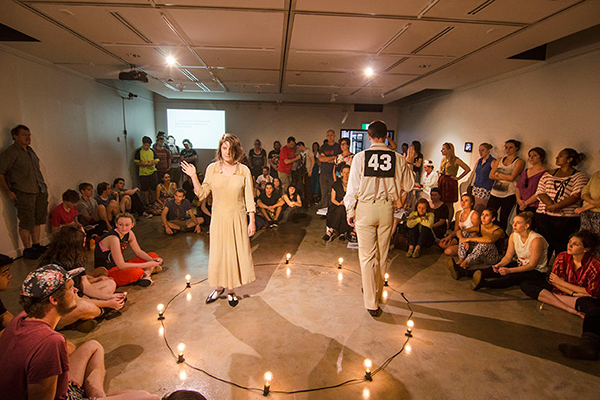March 11, 2014
Broken bodies pay tribute to a bygone craze in 24-hr dance marathon
“One couple, and only one, will waltz out of here over broken bodies, broken dreams, carrying the grand prize of $1500 silver dollars”, cries actor Gigi Young’s character Rocky in the 1969 Sydney Pollack film They shoot horses, don’t they?
Inspired by Horace McCoy’s 1935 novel of the same name, the movie goes on to depict the bizarre and cruel dance marathon craze of the 1930s Great Depression when the unemployed and desperate signed up to have a chance at winning the cash prizes offered.
The marathons could last hours, days, weeks and even months as the contestants were pushed to the brink of physical and emotional breakdown.
A recent University of Wollongong (UOW) performance relived the phenomenon in a 24-hour dance marathon called Yowza Yowza Yowza, created and directed by UOW PhD candidate Deborah Pollard.
Over 24 unbroken hours, performers Jackson Davis and Carly Young fought physical, mental and emotional fatigue as they slow danced non-stop and recreated photographs made famous by the early dance marathons.
The dancers slowed to a modest shuffle about the floor as the clock wound until it finally struck zero and the crowd erupted into cheers.
"We're feeling just tiredness, but other than that we're not as bad as we thought we would be," Ms Young told the Illawarra Mercury shortly after the dance finished.
"It was quite emotional for both of us because the walk we did took so long, it was like the countdown was slowly, finally coming."
Ms Pollard said the now legendary marathons were a cocktail of vaudevillian acts, fake weddings and overacting on the part of the emcees combined with the real exhaustion and desperation of the contestants.
“Yowza Yowza Yowza seeks to reflect this duality; it is a mix of theatrical enactment and real time exhaustion,” she said.
“For me this work is all about exhaustion: the exhaustion of a bygone era brought into the present time and space of the gallery, contrasting and intertwining the past with the present.
In further tribute to the Depression-era events, the UOW performance was webcast live allowing an unknown audience to be entertained by the dancers’ travails.
“In the 1930s marathons, the uncensored and unedited performances undertaken by ordinary people deprived of sleep were a cheap and popular form of mass entertainment,” Ms Pollard said.
“Audiences either followed the journey of the contestants by attending the events or via live radio broadcasts.
“They might even be understood as an early prototype reality television.”
More information: yowzayowzayowza.tv
